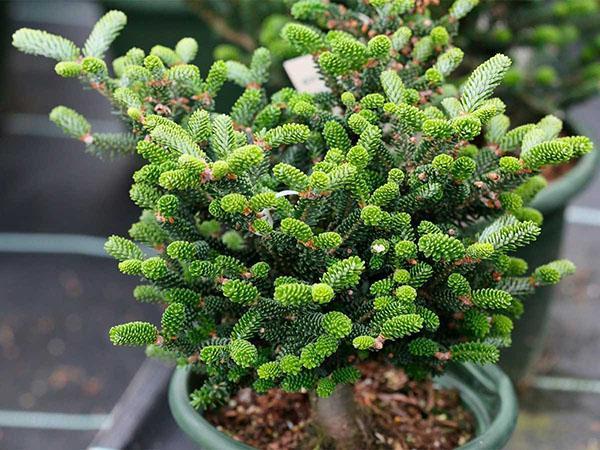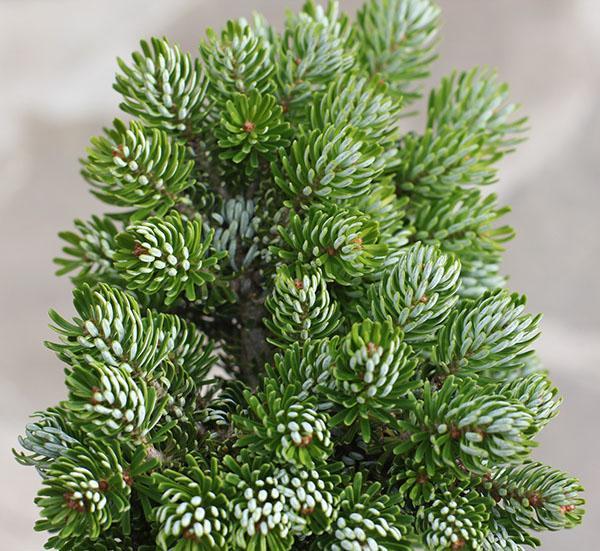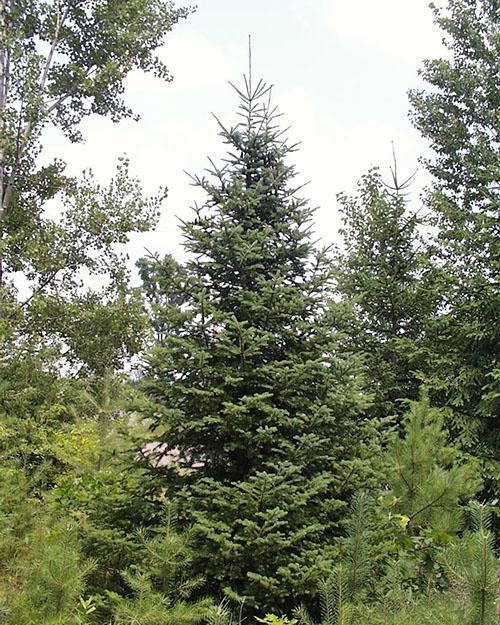Fir: planting and caring for a plant in the open field
 Fir, which is easy to plant and care for, is popular not only among professional gardeners, but also among beginners. This is a beautiful plant belonging to the famous Pine genus. In the wild, the tree can be seen in coniferous forests along with cedar, pine and spruce.
Fir, which is easy to plant and care for, is popular not only among professional gardeners, but also among beginners. This is a beautiful plant belonging to the famous Pine genus. In the wild, the tree can be seen in coniferous forests along with cedar, pine and spruce.
Features of fir

The fir root system is well developed and powerful. The leaves are presented in the form of flat needles that taper at the base. They are painted in a deep green shade with two white stripes at the bottom.
Male flowers of the classical form. Females are presented in the form of cylindrical or ovoid bumps. Inside each fruit there are flat grains. The plant is pollinated by the wind, after which the cones grow and open.
Fir cones are directed upward.
The main types of fir:
- Balsamic (Abies balsamea). The homeland of such a fir is the United States. It can also be found in Canada. Balsam fir is a shade-loving species. It grows from 15 to 20 m tall. With proper care, the trunk reaches 0.7 m in diameter. Young specimens have a grayish bark. The buds are resinous, light green in color. The buds reach 10 cm in length. Due to its characteristics, balsamic fir is planted both as a single plant and in group plantings.

- Korean (Abies koreana). This species is characterized by slow growth. Adult specimens reach 15 m, and the trunk diameter is 0.8 m. The needles are lush, tough. Cones are elongated, cylindrical in shape. They grow up to 7 cm long.

- Caucasian or Nordmann (Abies nordmanniana). In the wild, the tree is found only in the Caucasus Mountains. Fir grows up to 60 m tall. Crohn of narrow conical shape, lush. The length of each needle varies within 4 cm. The cones are long, greenish in color. Mature fruits become dark brown in color.

It is recommended to grow fir in one place no more than 300 years.
One-color fir is no less popular. It differs in needles of a bluish hue. Oval cones up to 14 cm long.
Fir: planting and care in the open field
 Only those specimens that are 4 years old should be planted in open ground. The procedure is carried out in the month of April. Autumn planting of fir falls in August or the first part of September.
Only those specimens that are 4 years old should be planted in open ground. The procedure is carried out in the month of April. Autumn planting of fir falls in August or the first part of September.
In order for the seedlings to start quickly, they need to be planted only in cloudy weather.
The place for the fir should be chosen in partial shade or in the shade. The soil should be fertile and flow well. Loamy soil is an excellent option.
Fir planting stages:
- Two weeks after planting, you need to prepare a hole. Its size should be 60 * 60 * 60 cm.
- Then pour from 20 to 30 liters of water to the bottom. As soon as all the liquid is absorbed, dig up the bottom on the bayonet of the shovel.
- Place drainage at the bottom of the dimple. It can be broken red brick, crushed slate. Also, large crushed stone is used as drainage.
- After laying the drainage, it is necessary to fill the depression with a mixture of peat, sand, humus and clay (1: 1: 3: 2). Also put some sawdust and nitrophosphate in the soil.
- After two weeks, as soon as the soil settles a little, you can start planting.The seedling is placed strictly in the center of the dimple, while it is important to ensure that the root collar is flush with the soil.
- Sprinkle the roots thoroughly with soil and tamp lightly. Then water the plant with water.
When planting fir in the country, it is important to observe the distance between specimens. The optimal indicator is a gap from 3 to 3.5 m.For compact types of fir, 2.5 m is enough.
In order for the tree to be beautiful and develop well, it is necessary to loosen the soil in a timely manner. It is recommended to carry out the procedure after each watering. Also, don't forget about weeds. They must be removed systematically.
Mulching
 Young specimens mulch... An excellent option is peat, sawdust, wood chips. The ball of mulch should be within 8 cm. It is important to ensure that the root collar is open.
Young specimens mulch... An excellent option is peat, sawdust, wood chips. The ball of mulch should be within 8 cm. It is important to ensure that the root collar is open.
Top dressing
The first fertilization is carried out at 2 or 3 years of plant life. The procedure is carried out in the spring. To do this, add 100 to 120 g of Kemira-wagon to the soil.
Irrigation
Only moisture-loving fir species are watered. For good development, 2 to 3 procedures for the entire season will be enough. 1.5-2 buckets of warm liquid are poured under each tree. But, if the weather is wet outside, then the amount of watering is reduced.
Fir pruning
 This procedure is carried out before sap flow begins. The first thing to do is to remove any dry and deformed twigs. After that, you can start forming the crown. It is recommended to trim the fir only with garden shears. They must be sharp so as not to damage healthy shoots. In one procedure, no more than 1/3 of the branches are removed. If you do not follow this rule, the fir will stop growing and lose its attractiveness.
This procedure is carried out before sap flow begins. The first thing to do is to remove any dry and deformed twigs. After that, you can start forming the crown. It is recommended to trim the fir only with garden shears. They must be sharp so as not to damage healthy shoots. In one procedure, no more than 1/3 of the branches are removed. If you do not follow this rule, the fir will stop growing and lose its attractiveness.
Fir transplant rules
 In order for the tree to quickly take root in a new place, all the rules of the procedure must be followed. The first thing to do is to gouge the soil around the trunk with a sharp shovel. Then lift the root system along with the earthy clod and transfer to a new place.
In order for the tree to quickly take root in a new place, all the rules of the procedure must be followed. The first thing to do is to gouge the soil around the trunk with a sharp shovel. Then lift the root system along with the earthy clod and transfer to a new place.
Specimens, which are already many years old, are prepared before planting. To do this, they poke the soil around the trunk in a year. During this time, new roots will appear in the middle of the created circle, thanks to which the fir will more easily transfer the transplant. In order to prevent the destruction of the earthy coma, it is recommended to carry out the procedure with a partner.
Diseases and pests of fir
 If you choose the right place for planting and follow all the rules for caring for the plant, then the tree will have good immunity. But, despite its resistance to disease, fir can infect aphids. The first sign of the appearance of such insects is yellowing of the needles. Removing aphids is not difficult. To do this, use the drug Antio or Rogor. The tree is sprayed in the month of March, when the female aphids begin to awaken. To do this, stir 20 g of a preparation in a bucket of clean water. These remedies will also help get rid of the fir moth and leafworm.
If you choose the right place for planting and follow all the rules for caring for the plant, then the tree will have good immunity. But, despite its resistance to disease, fir can infect aphids. The first sign of the appearance of such insects is yellowing of the needles. Removing aphids is not difficult. To do this, use the drug Antio or Rogor. The tree is sprayed in the month of March, when the female aphids begin to awaken. To do this, stir 20 g of a preparation in a bucket of clean water. These remedies will also help get rid of the fir moth and leafworm.
When chicks and stars appear, the trees are dug up and destroyed.
Also, yellow spots may appear on the tree, on which small growths are formed. They appear as a result of a fungus infection of the fir. The branches that have changed color must be removed. It is also recommended to get rid of needles that have fallen. Treat the whole plant with a solution of Bordeaux mixture.
Proper planting and caring for fir is a guarantee of a beautiful and healthy tree that will decorate the site for many years. By following all the recommendations, you will certainly achieve the desired result and make your yard beautiful, stylish and modern.